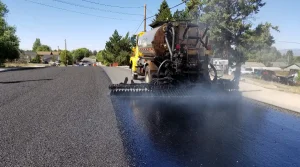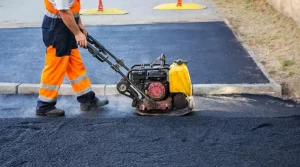The sun can harm your pavement due to this prolonged exposure to exceptionally high temperatures during a heat wave. The sun’s UV rays can cause the asphalt to fade in color during the warm summer months and even more so during intense and protracted periods of heat. They can also generate soft areas, which, if ignored, can result in potholes. The asphalt surface can be more easily scratched, scuffed up by vehicle traffic, and even start to chip away due to the frequent exposure to and absorption of this heat. This heat may also cause fissures, which would allow water to flow into the sublayers. This causes air spaces to develop in the asphalt pavement’s structure, and when pressure from above, such as the weight of moving traffic and cars, is exerted, the top layer starts to sag and disintegrate, creating potholes. In addition, it has a bleaching effect on asphalt, which might eventually cause it to turn gray rather than the deep black it originally was.
Two typical heat-related problems with asphalt to look out for
Cracking is a typical asphalt damage type brought on by extended heat exposure. Even while cracking is more common in older surfaces, it can happen in new buildings if they were placed incorrectly or aren’t being properly maintained, including with routine seal-coat applications. Parking lots and business warehouses are typical examples of surfaces affected by this condition.
Oxidation, which weakens the asphalt’s overall structure and makes the surface fragile, is another item to watch out for. The amount of binding oils in the asphalt is decreased as a result of the chemical reaction that occurs when light oils combine with heavier ones due to UV radiation from the sun. Cracking and/or raveling become more frequent as oxidation advances.
Keeping Your Asphalt Safe From Heat Damage
Since sealcoating shields asphalt, heat damage can be avoided or reduced by routinely reapplying this shield. When the heat is on, sealcoating works best because the greater temperatures assist the materials to adhere to the surface. The viscosity of the asphalt is also reduced by the higher temperatures, which makes it easier for sealcoating to penetrate deeper cracks and crevices and safeguard both the surface and the sub-layers.
It’s not too late to make up for whatever damage your asphalt may be displaying. By being proactive and making the necessary repairs sooner rather than later, you may extend the useful life of your asphalt and avoid the inconvenience and expense of a complete replacement.







